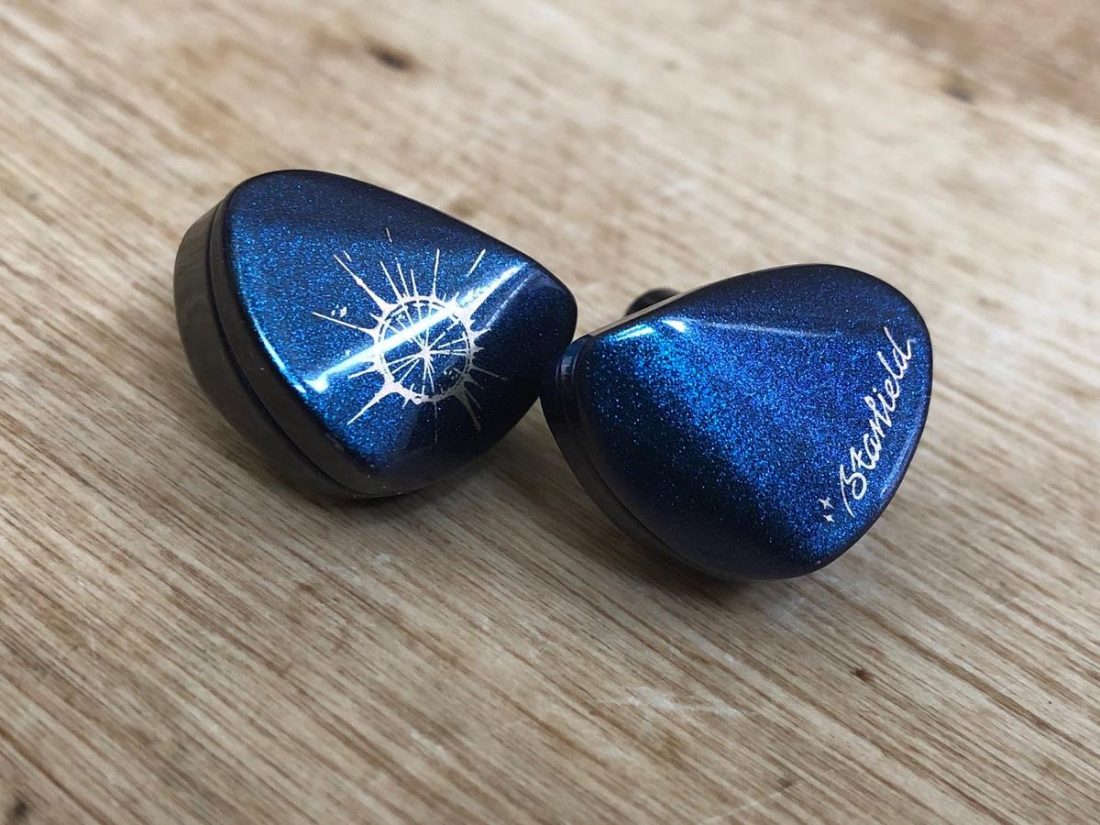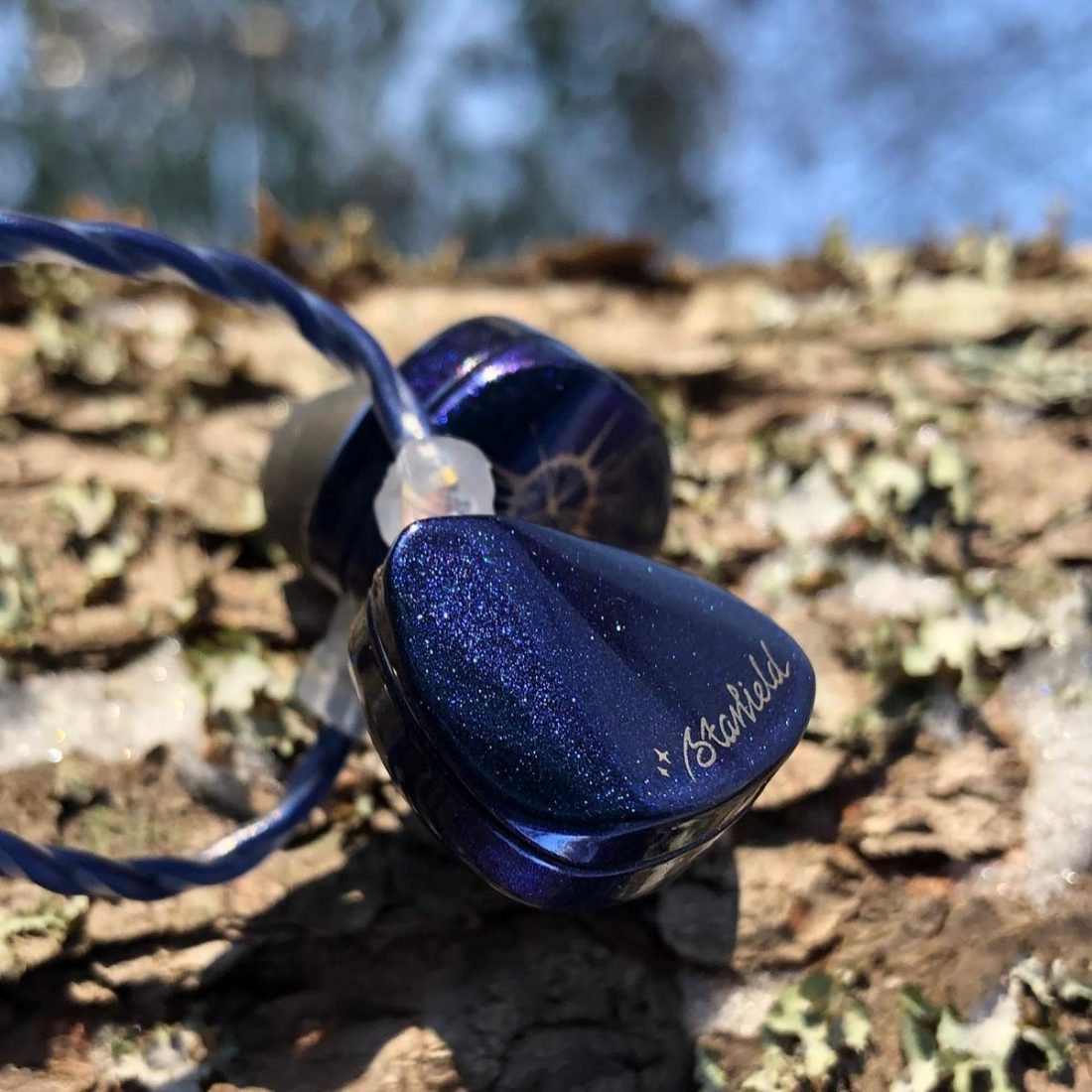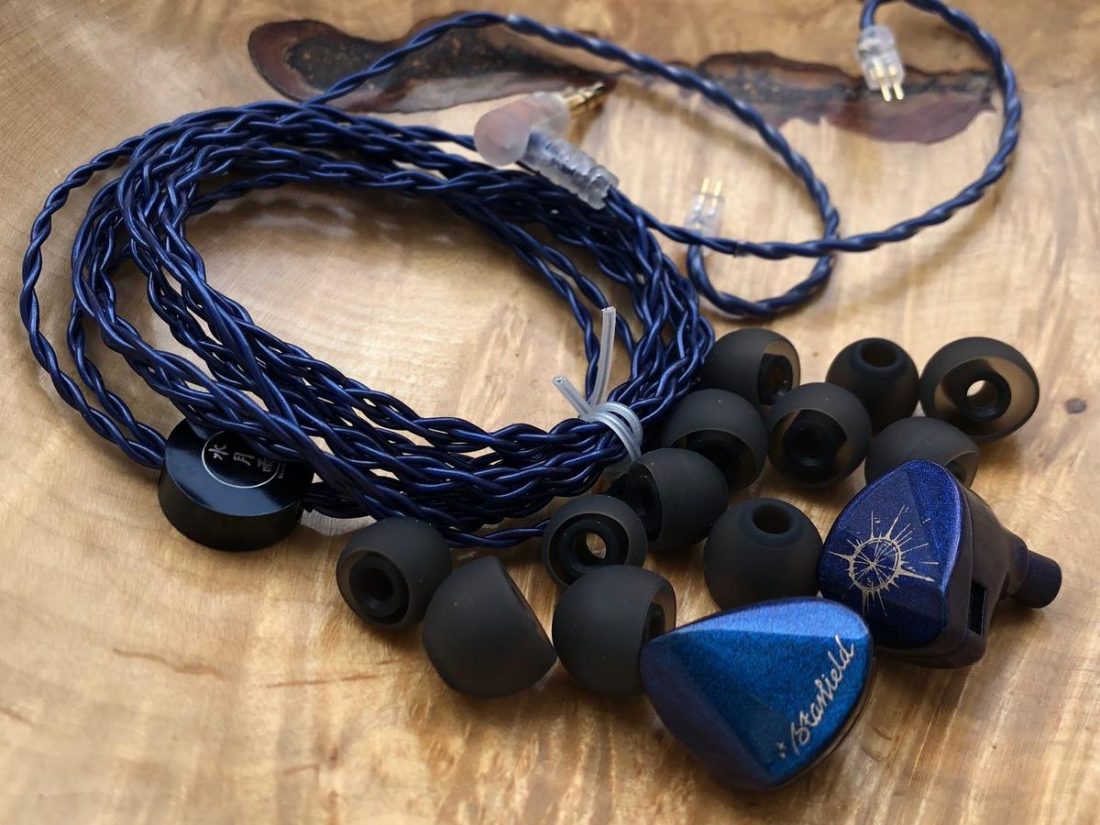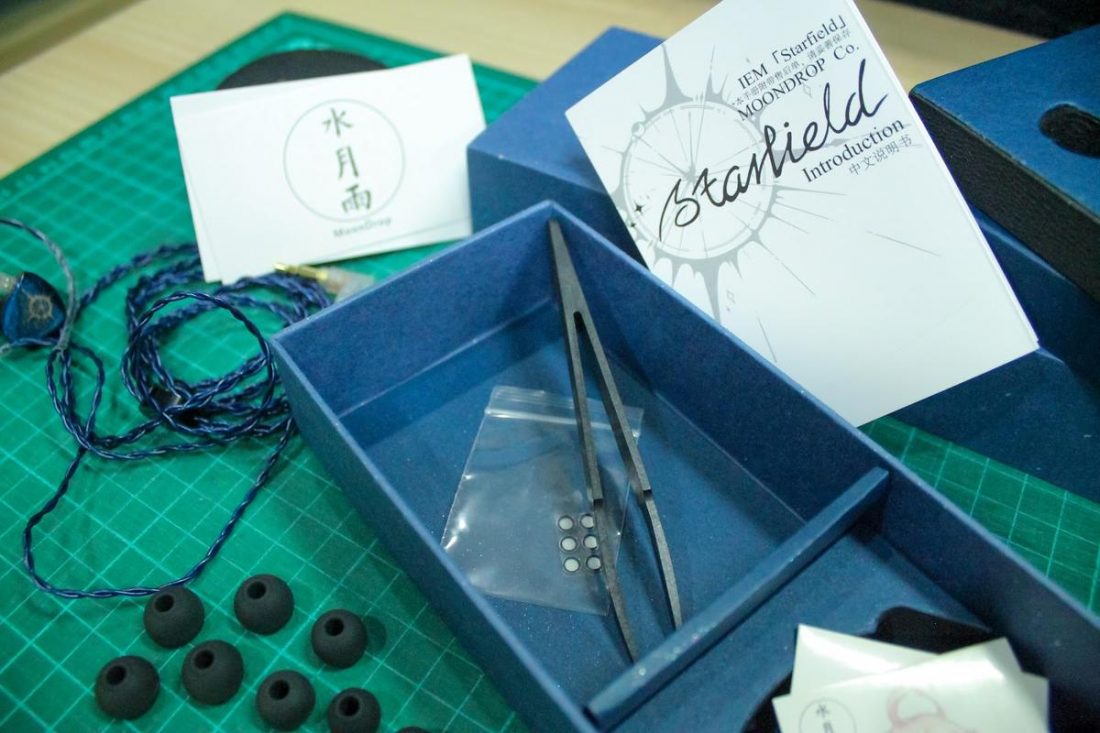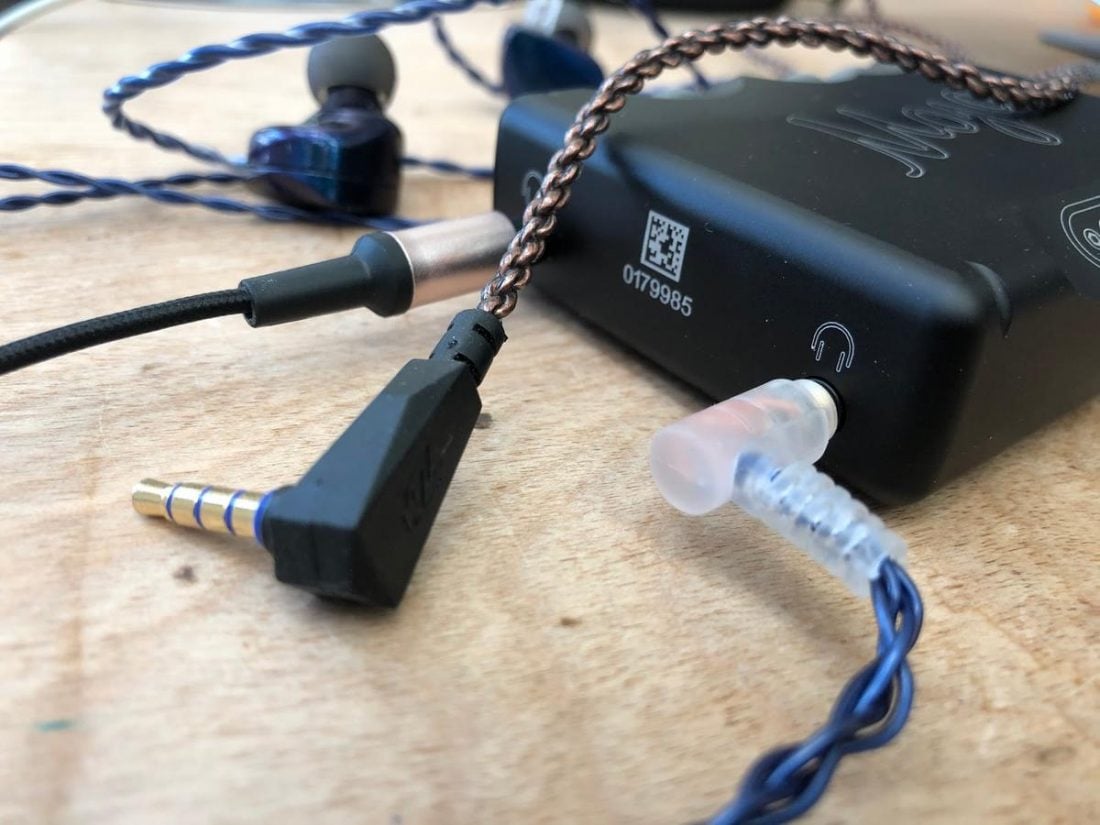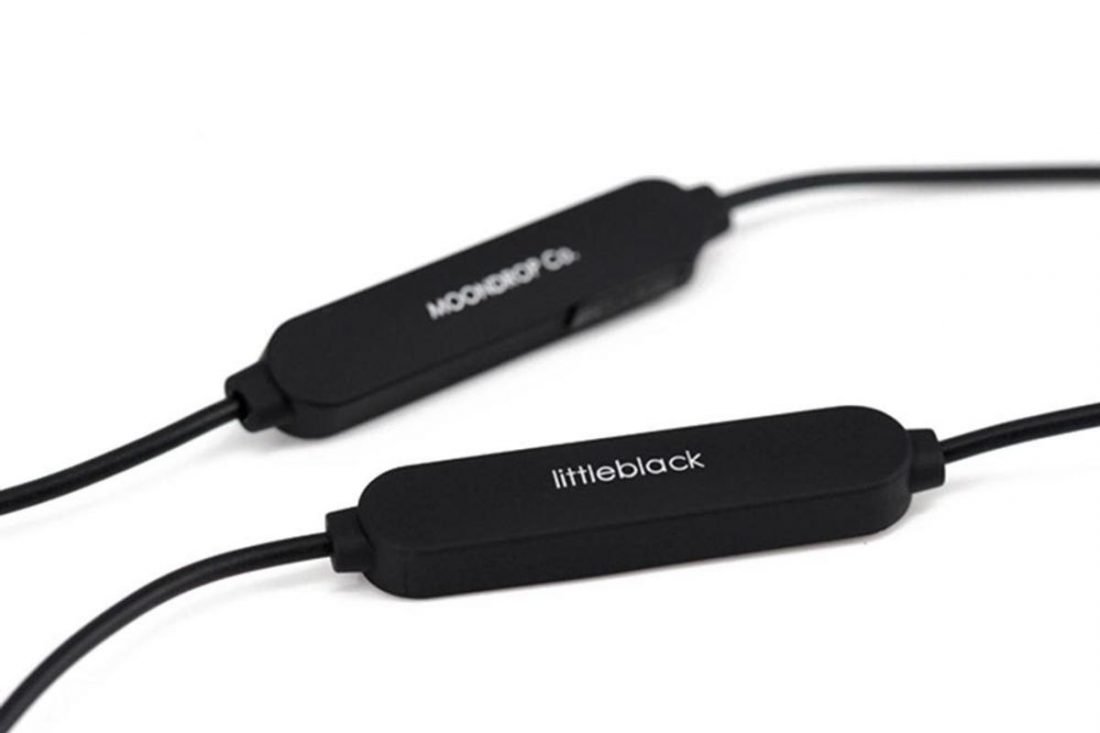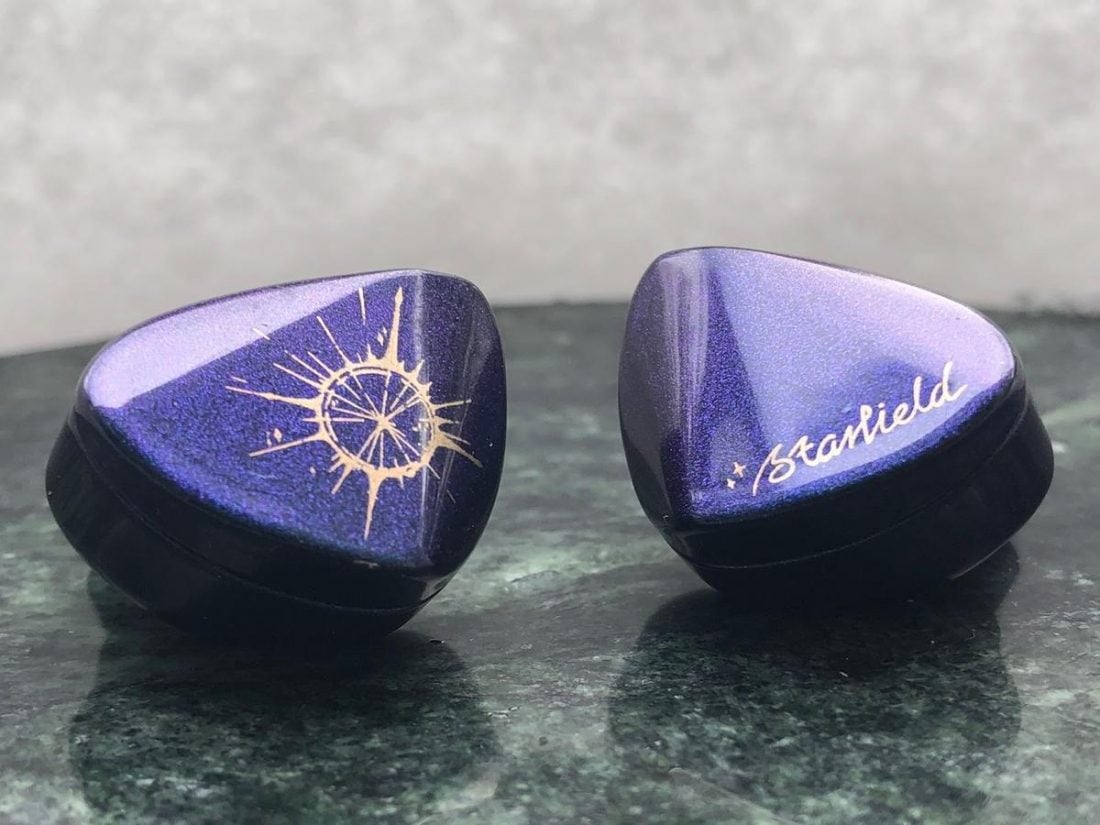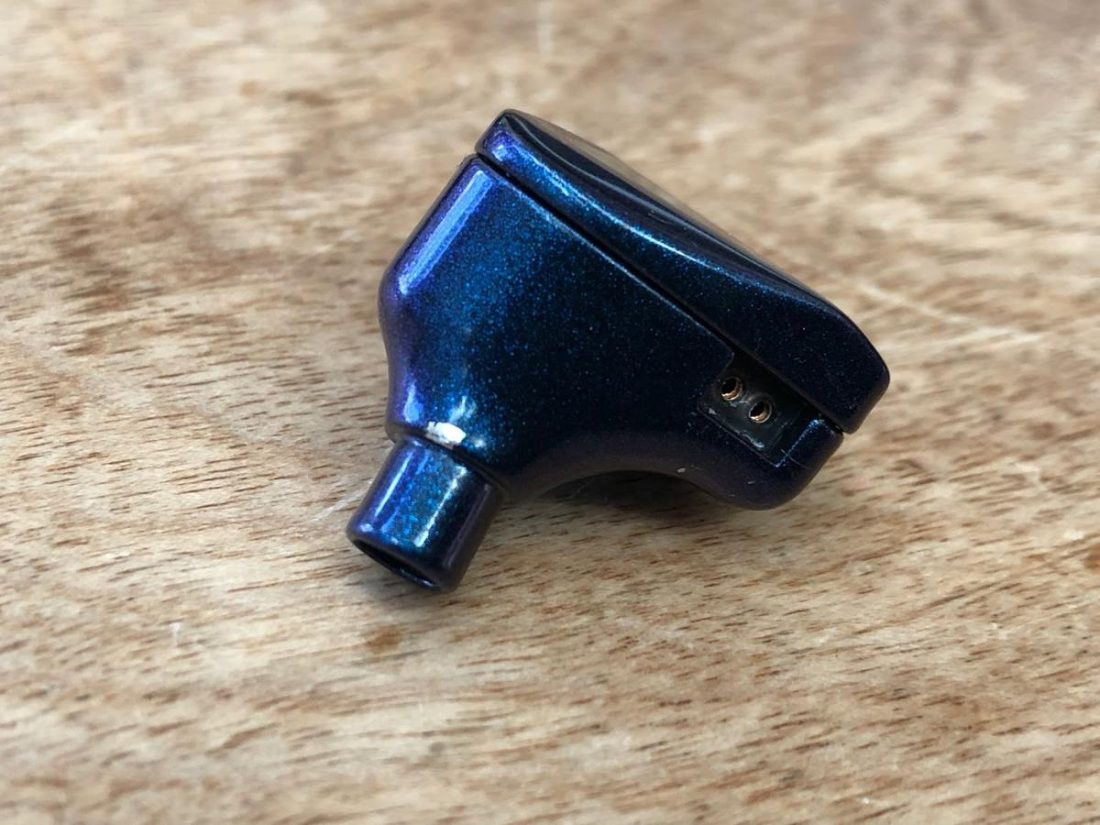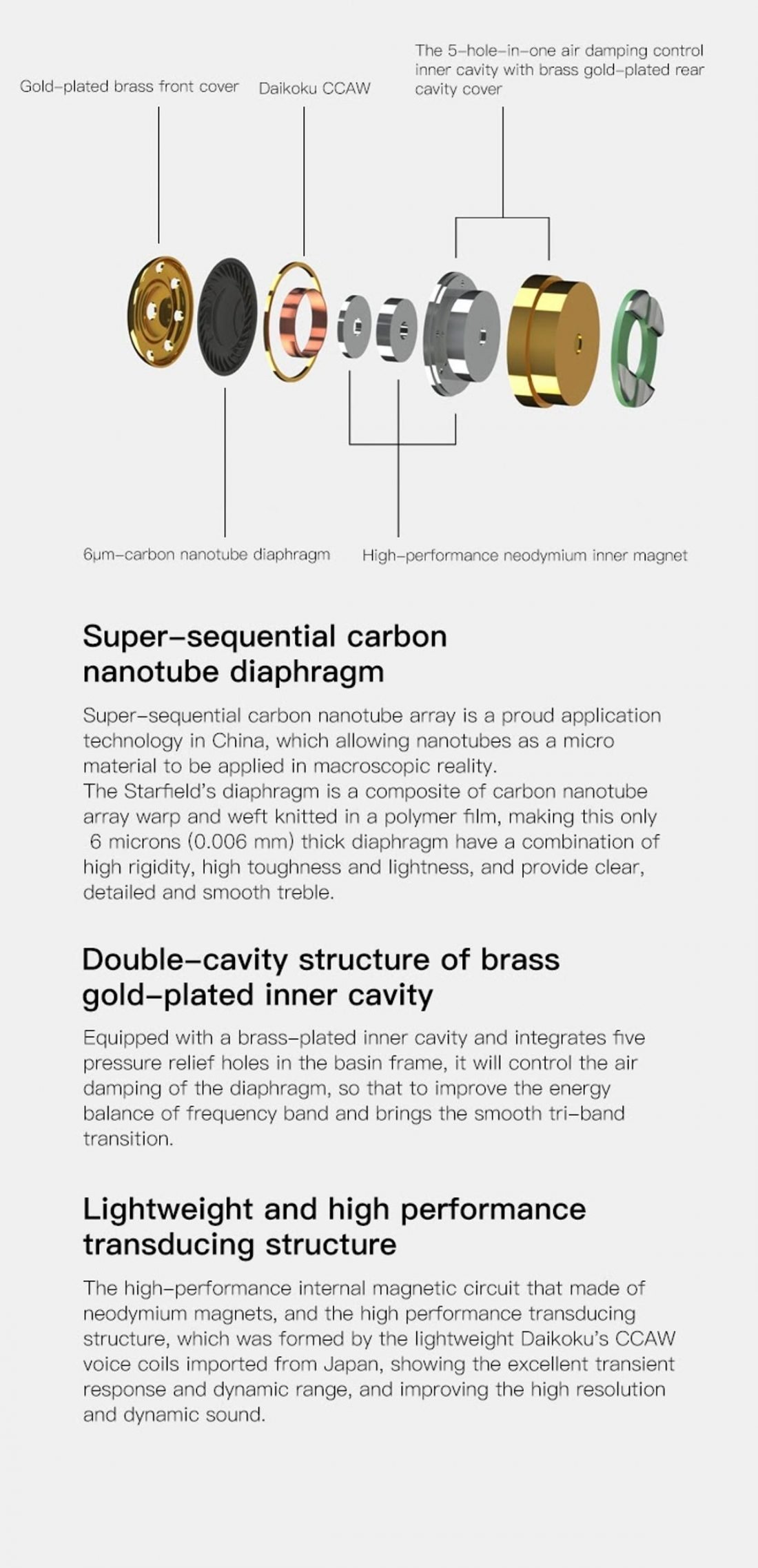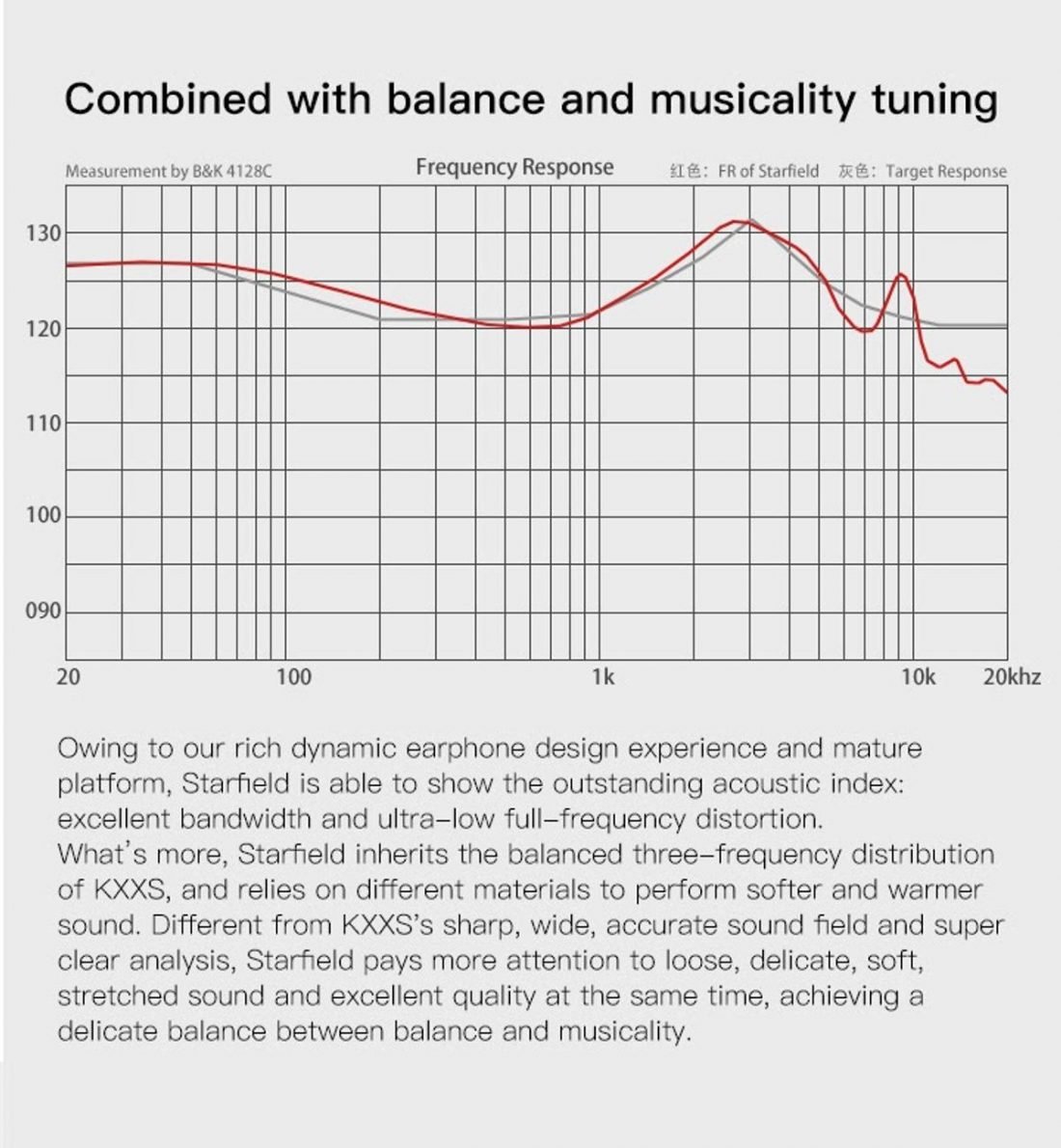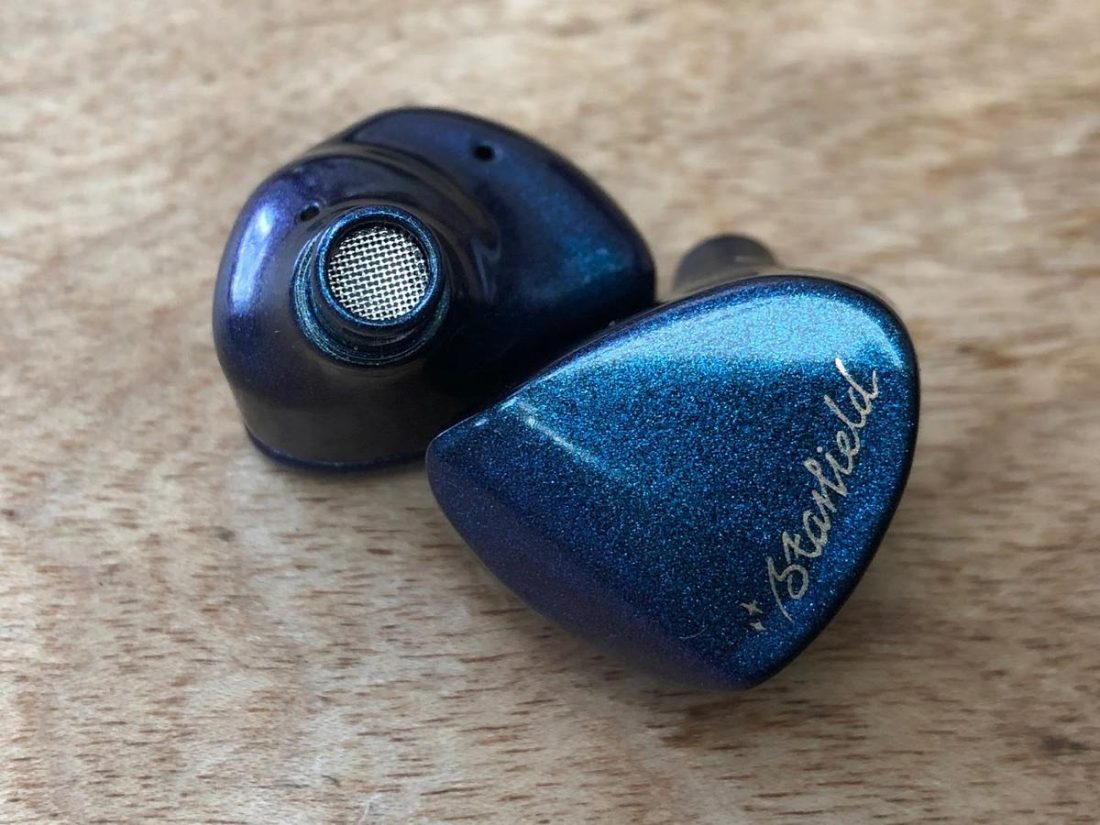MoonDrop Technology Co., Ltd. is a Chinese IEM manufacturer that has garnered much interest within the headphone enthusiast community due to the success of their Kanas Pro and KXXS IEMs. They are known for tuning based on the Harman Target Curve, and for producing excellent sounding mid-range IEM options ($100-$200). Their latest offering, the $109 Starfield, has been eagerly anticipated. MoonDrop was formally established in 2015, and from the beginning, they have remained focused solely on the design and creation of IEMs and earbuds. They describe themselves as a “studio composed of several enthusiasts.” Their enthusiasm appears infectious, as although this is my first ‘ears-on’ experience with one of MoonDrop’s products, I’ve only encountered positive word of mouth. The Starfield is aptly named. It’s an exquisitely finished product, spectacularly painted like a clear nighttime sky. The deep blue colorway is imbued with shimmering sparkles. This design is beautifully captured by the name ‘Starfield’. Bravo! The Starfield are single dynamic driver IEMs, unlike so many of the multi balanced armature and hybrid designs that are so popular right now. It eschews MoonDrop’s standard DLC (Diamond-Like Coating) diaphragm to use a new 10mm CNT (Carbon Nanotube) diaphragm. MoonDrop claims that this new diaphragm design offers “excellent bandwidth and ultra-low full-frequency distortion” and while the sound remains balanced like the KXXS, it has a “softer and warmer sound. Different from KXXS’s sharp, wide, accurate sound field and super clear analysis, Starfield focus on delicate, soft, stretched sound and excellent quality bringing a delicate balance between balance and musicality.” As per usual, it’s up to us to decide if the listening experience lives up to the marketing hype.
The Challenge of In-Ear Monitor Reviews
I’d like to add a caveat. IEMs are notoriously difficult to review and compared to full-size headphones, it is problematic to trust that the review findings will be applicable to all readers. While the size of one’s ear may impact the comfort or the sound of full-size headphones, small details like the inner shape of a reviewer’s ear and the fit of an IEM greatly impacts not just the listener’s comfort but dramatically changes the perceived performance of an IEM. This is compounded by the plethora of ear tip sizes, materials, and shapes (which may or may not be included with the IEM) all of which uniquely fit different people. Most significantly, the quality of the ear tip seal within the ear changes the sound. So, beware dear reader, what suits one reviewer may not be applicable to you.
Technical Specifications
Driver: 10mm dual cavity dynamic driver with Carbon Nanotube diaphragm Cable: 24 AWG Litz 4N OFC Cable connectors: 0.78 2-pin Sensitivity: 122dB/Vrms (@1khz) Impedance: 32Ω±15% (@1khz) Frequency response: 10Hz – 36kHz Effective frequency response: 20Hz – 20kHz (IEC60318-4)
Packaging and Accessories
I received a review set of Starfield IEMs, and as such did not get the usual retail packaging. My set came in a few small clear plastic ziplock bags with just the IEMs, cable and silicone ear tips in varying sizes. The actual retail packaging is a very attractive blue cardboard box which matches the Starfield aesthetic. It consists of many thin wire strands, individually insulated and twisted or woven together, following one of several carefully prescribed patterns often involving several levels (groups of twisted wires are twisted together, etc.). The result of these winding patterns is to equalize the proportion of the overall length over which each strand is at the outside of the conductor.” – Wikipedia
In the Retail Box
1 pair of MoonDrop Starfield IEMs 50 inch, 24 AWG Litz 4-core braided, Oxygen-Free Copper (OFC) cable (pearlescent blue) with 3.5mm plug and dual 0.78 2-pin connectors 6 pairs of silicone tips (2 small, 2 medium and 2 large) Zippered round storage case 6 replacement mesh filter grills Tweezers Introduction manual
The included accessories are more than adequate for IEMs at this price point. The tweezers and replacement mesh grills for the nozzle are fairly unusual inclusions. It’s a nice bonus to receive a proper zipping storage case.
Cable
MoonDrop seems quite proud of their included cable and marketing material describes it as “a 24 AWG Litz structure 4N purity OFC earphone cable, which ensures rich sound details and full dynamics.” They even added pearlescent power to the rubber coating to match the sparkly look of the IEMs themselves. To be honest, this is a case where the marketing description grossly oversells the reality of the product. The color is a good match, although it is difficult to see any real shine in the cable. The clear rubber encased 3.5 mm jack and the .78 2-pin connectors are functional if not exactly confidence-inspiring. The cable feels very thin and flimsy. I think the (much-maligned) stock KZ IEM cables feel (and look) far superior, less fragile, and much more premium. I have serious concerns regarding the Starfield cable’s longevity. Thankfully it is easily replaceable. After my initial inspection, it appeared that left and right is unlabelled on the cable and that the 2-pin connector orientation is likewise unlabelled. I assumed that the writing on the round black plastic cable Y-split faced front, and then I assigned the left and right cables based on that. It turns out that under a strong light, I can make out a tiny L and R engraved on one side of the translucent rubber 2-pin connector housings. Seriously, these are almost impossible to see. It appears that I was correct in my guess of left and right, and based on the curve of the cable, the L and R labels have to be faced to the inside when plugged in. Yeesh. A little color coding and better labeling would go a LONG way here. MoonDrop does offer a Bluetooth replacement cable, the Littleblack. It is Bluetooth 5.0, supports aptX, AAC, and SBC, has 7 to 8 hours of battery life, and up to 100 hours of standby time. It also fits the MoonDrop KXXS and A8 IEMs.
Build Quality
I’ve said it before, but it is worth repeating: The Starfield are gorgeous IEMs. The starry sky paint job on the shells is spectacular. Depending on the light source, it not only sparkles but displays a gradient of colors. This lovely coating is applied over zinc-aluminum alloy, die-cast shells. This gives the Starfield an excellent intrinsic feeling of value. These are no plastic, light-weight, cheap-feeling Chi-Fi wonders. Each IEM weighs 9 grams without cable or ear tip. Compare this to only 5 grams for each resin and metal shelled KZ ZST IEM. The weight makes them feel valuable, but it may lead to comfort or fatigue issues for some users. Thankfully the shape is smooth and tailored to the shape of the ear. They are medium to small-sized and fit nicely in my smallish ears. Even with long listening sessions, I never experienced any lack of comfort or usability. The seam isn’t perfectly flush at the recessed 2-pin socket, although this may have been intentional for some reason I can’t fathom. The nozzles have fine silver mesh screens in them, but no exterior lip to retain the ear tip. That being said, tips remained firmly in place throughout my testing. MoonDrop states that the inner cavity is made of gold-plated brass, and integrates 5 pressure relief vents. Magnets are neodymium and the transducer is made of Daikoku’s copper-clad aluminum wire (CCAW) voice coils imported from Japan, which they claim creates, “excellent transient response and dynamic range, and improving the high resolution and dynamic sound”.
Carbon Nanotube Array Technology
According to MoonDrop, “Super-sequential carbon nanotube array is a proud application technology in China, which allowing nanotubes as a micro material to be applied in macroscopic reality.” Well. There you go. Sounds pretty high-tech. They go on to proclaim that the “diaphragm is a composite of carbon nanotube array warp and weft knitted in a polymer film, making this only 6 microns (0.006 mm) thick diaphragm have a combination of high rigidity, high toughness and lightness, and provide clear, detailed and smooth treble.” Ok. So that leads us to an obvious question. What is a carbon nanotube diaphragm? In 2013, a new headphone diaphragm technology debuted. Rather than using a standard moving diaphragm, the sound was produced using the thermoacoustic effect. In essence, microscopic tubes of carbon (excellent conductors of heat and energy) were heated and cooled. As the nanotubes expanded and contracted, they created sound waves. According to Chemical and Engineering News, “processing the carbon nanotube film into thin yarn arrays doesn’t weaken the thermoacoustic effect but can greatly improve the device robustness and durability.” As mentioned above, carbon nanotube technology is appearing in a number of well-regarded Chi-Fi IEMs. All seem to share a 10mm driver size. It makes me wonder if they are utilizing the same driver. In any case, all seem to be receiving fairly universal acclaim for good sound quality, so they may be onto something with this whole carbon nanotube thing.
Sound Quality
By coincidence, I received JVC’s HA-FW01 IEMs in the same week as the Starfield. While several times more expensive, they are also (coincidentally) single dynamic driver IEMs. So of course, I compared them. Who wouldn’t? Impressively, the Starfield held their own in sound quality, regardless of the price discrepancy. The Starfield really do sound as good as they look. They provide an excellent and balanced sound signature that is exceptionally smooth and easy to listen to. I’m a fan of the Sennheiser HD650 and Audeze LCD-2 kind of sound, which tends towards excellent midrange, slightly rolled-off highs and respectable low end. Overall, a relaxed and smooth sound that makes it easy to just enjoy the music. The Starfield fit my tastes very well. While I tested the Starfield with the impressive Hagerman Tuba amplifier, I kept in mind that these are IEMs and as such are meant for portability. So, they got most of their listening from my iPhone and a Chord Mojo DAC/amp. The Starfield is plenty efficient enough to work properly driven directly from a smartphone.
Bass
The Starfield reproduce tight and full bass, with ample lower sub-bass. This brings warmth and fullness to the sound without overpowering the rest of the frequencies. Notes hit with a punchy and controlled impact and are more than adequate to get toes tapping and your head bobbing. These aren’t bass-head IEMs and have a balanced sound with sufficient low end to still be fun.
Midrange
The midrange takes a bit of a back seat with regards to the low end. Not to say that it isn’t good sounding (because it really is), just that the midrange is not quite as pronounced. Voices remain natural and clear on the Starfield. Overall the midrange is transparent and uncolored, (and most noticeably) without excessive warmth or thickness. There is nothing unnatural sounding going on here.
Treble
This is such a smooth sounding pair of IEMs. The Starfield gives plenty of detail without becoming grainy or too analytical. The very high end seems to roll off gently, avoiding any sibilance or harshness. This balance really works for me: sufficient texture and detail coupled with plenty of ‘oomph’ when the music calls for it. The Starfield conveys a remarkable feeling of delicacy in the sound it delivers. The lack of thickness to the midrange yields the impression of delivering every subtle nuance within the music. In comparison, the KZ ZSX sound denser and less delicate than the Starfield. The ZSX is much more in your face and feels like every frequency is dialed up to the top. This special combination of delicacy and lightness means the Starfield is better able to just disappear within the music. Rather than the IEMs demanding your attention, the music takes center stage and is the real ‘star’ (ahem).
Conclusion
Thank you to Hifigo for sending the MoonDrop Starfield to Headphonesty for review. You can purchase the IEM at their website. Right. So, I learned something with this review. Affordable single dynamic driver IEMs have not been fully eclipsed by multi-driver hybrid IEMs. Not for my tastes at least. Good to know! Lately, I’ve been caught up in the quality of what can be found at around the $50 IEM price point. The KZ ZST or ZS10 Pro really is shockingly good options for the money. So, what does an IEM with a single driver at twice the price get you? Excellent build quality, with full metal shells and an unparalleled paint job. And what comes from that beautiful housing? Nothing short of incredibly subtle, smooth and balanced sound. However, life’s all about compromises. At around the $100 price point, not everything can be great. What’s with that cable? It simply doesn’t match the overall quality of the Starfield IEMs. It feels cheap and it tangles easily. It is all but impossible to see how to connect it properly. All in all, it’s pretty awful. Litz braid, OFC wire, and iridescent powder just aren’t going to save it. The cable functions, it sounds fine, and best of all it is easily replaced. There. See? I can find good things to say. With the current buzz around all the single driver, carbon nanotube diaphragm Chi-Fi IEMs, it’s hard not to get caught up in the excitement. Now that I’ve had listening time with the MoonDrop Starfield, I can absolutely report that I understand the hype. The technological advancements in affordable IEMs keep coming at a rapid-fire pace, and it’s an unprecedentedly good time to be involved in this hobby. The sound quality available from the lower end of the price scale is truly remarkable. The MoonDrop Starfield offers another noteworthy high-point in the ever-evolving bang-for-the-buck category.

